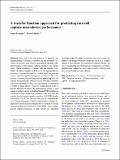| dc.contributor.author | Smith, James P. | |
| dc.contributor.author | Kirby, Brian J. | |
| dc.date.accessioned | 2016-11-07T21:50:25Z | |
| dc.date.available | 2016-11-07T21:50:25Z | |
| dc.date.issued | 2015-05 | |
| dc.identifier.issn | 1387-2176 | |
| dc.identifier.issn | 1572-8781 | |
| dc.identifier.uri | http://hdl.handle.net/1721.1/105241 | |
| dc.description.abstract | Rare cells have the potential to improve our understanding of biological systems and the treatment of a variety of diseases; each of those applications requires a different balance of throughput, capture efficiency, and sample purity. Those challenges, coupled with the limited availability of patient samples and the costs of repeated design iterations, motivate the need for a robust set of engineering tools to optimize application-specific geometries. Here, we present a transfer function approach for predicting rare cell capture in microfluidic obstacle arrays. Existing computational fluid dynamics (CFD) tools are limited to simulating a subset of these arrays, owing to computational costs; a transfer function leverages the deterministic nature of cell transport in these arrays, extending limited CFD simulations into larger, more complicated geometries. We show that the transfer function approximation matches a full CFD simulation within 1.34 %, at a 74-fold reduction in computational cost. Taking advantage of these computational savings, we apply the transfer function simulations to simulate reversing array geometries that generate a “notch filter” effect, reducing the collision frequency of cells outside of a specified diameter range. We adapt the transfer function to study the effect of off-design boundary conditions (such as a clogged inlet in a microdevice) on overall performance. Finally, we have validated the transfer function’s predictions for lateral displacement within the array using particle tracking and polystyrene beads in a microdevice. | en_US |
| dc.description.sponsorship | National Cancer Institute (U.S.). Physical Sciences-Oncology Center (Cornell Center on the Microenvironment and Metastasis. Award U54CA143876) | en_US |
| dc.publisher | Springer US | en_US |
| dc.relation.isversionof | http://dx.doi.org/10.1007/s10544-015-9956-7 | en_US |
| dc.rights | Article is made available in accordance with the publisher's policy and may be subject to US copyright law. Please refer to the publisher's site for terms of use. | en_US |
| dc.source | Springer US | en_US |
| dc.title | A transfer function approach for predicting rare cell capture microdevice performance | en_US |
| dc.type | Article | en_US |
| dc.identifier.citation | Smith, James P., and Brian J. Kirby. “A Transfer Function Approach for Predicting Rare Cell Capture Microdevice Performance.” Biomedical Microdevices 17.3 (2015): n. pag. | en_US |
| dc.contributor.department | Lincoln Laboratory | en_US |
| dc.contributor.mitauthor | Smith, James P. | |
| dc.relation.journal | Biomedical Microdevices | en_US |
| dc.eprint.version | Author's final manuscript | en_US |
| dc.type.uri | http://purl.org/eprint/type/JournalArticle | en_US |
| eprint.status | http://purl.org/eprint/status/PeerReviewed | en_US |
| dc.date.updated | 2016-08-18T15:44:27Z | |
| dc.language.rfc3066 | en | |
| dc.rights.holder | Springer Science+Business Media New York | |
| dspace.orderedauthors | Smith, James P.; Kirby, Brian J. | en_US |
| dspace.embargo.terms | N | en |
| mit.license | PUBLISHER_POLICY | en_US |
| mit.metadata.status | Complete | |
